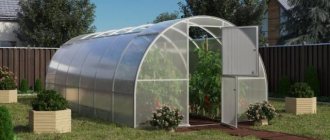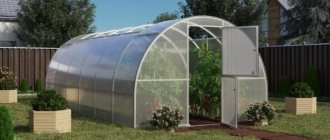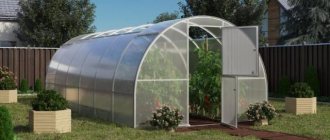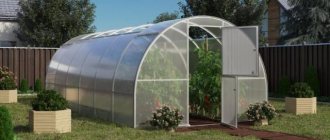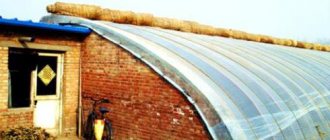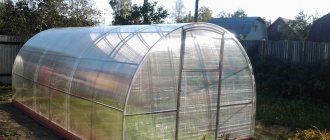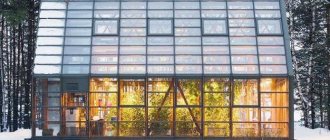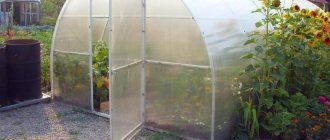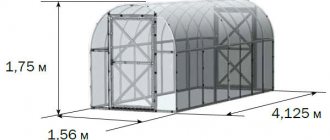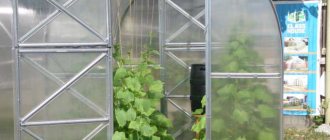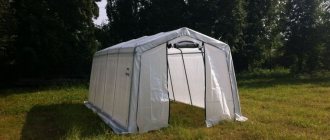Choosing a location for installation
The manufacturer guarantees that the greenhouse can be installed on any flat area.
However, the structure is a reinforced structure, so assembly experts recommend building a foundation. It will be enough to build a log base from 100*100 mm timber. The site on which the structure will be located must be in an open, sunny and windless place. A hard and level soil surface will protect the greenhouse from distortions.
The location of the greenhouse close to the house or barn will increase ease of use. Since there is always a need to carry buckets, boxes, and a fertilizer sprayer into it. But it is also necessary to take into account the proximity of the water supply point.
If the size of the plot allows you to squeeze the greenhouse only between the beds, you should leave space under the path for convenient passage.
Useful tips for installing a greenhouse
The yield you can get from a greenhouse without a roof depends on many factors, for example, its location
Therefore, it is worth paying great attention to the installation of the structure
It is important to correctly position the opening greenhouse on the site. Source homeli.ru
Here are the basic principles for installing a greenhouse:
- The area
where the greenhouse is located should be
sunny and not subject to drafts
, then the room will quickly warm up. - You should not place the greenhouse next to trees
, because leaves and fruits will fall from them, and the crown will
block the sun
. - Before installation, you need to level the site
so that the greenhouse does not skew.
It is better if the soil
is
hard
. - It is more rational to locate the greenhouse near the harvest storage areas
and
close to the water supply
. - You should not place the greenhouse right next to the garden bed
, because then you will have no access and no room to work.
How much does a greenhouse with an opening roof cost?
One of the most budget-friendly options for a sliding greenhouse is “Marusya”. The frame is made of galvanized pipe 25x25 mm, its standard pitch is 1-0.5 m. The Marusya greenhouse can be installed either on a foundation or without a foundation. Please note that its length along the center line should be 2.07 / 4.11 / 6.15 / 8.19 / 10.23 meters, in accordance with the length of the greenhouse, and its width should be 2, 2.5 or 3 meters.
The Marusya greenhouse is well adapted to the Russian winterSource poradum.com.ua
A two-meter version of “Marusya” with an arc pitch of 70 cm will cost 12,000 rubles. A four-meter one will cost 16,900 rubles, and a ten-meter one will cost as much as 35,000. Moreover, many companies and trading platforms offer their assembly services. This option in the Moscow region costs approximately 6,000 - 10,000 rubles, depending on the length.
A 3x4 m "Tulip" greenhouse will cost approximately 13,500 rubles, and the same model 6 m long will cost 17,500 - 18,500 rubles. The same greenhouse with an opening top 10 m long costs about 46,000 rubles. The price is indicated taking into account the cost of polycarbonate.
“Botanik” costs even more. Such a 3x2 greenhouse with a glass coating and an aluminum frame will cost 60,000 rubles. If you increase the length by another 2 m, the price will be approximately 74,000 in Russian currency. The ten-meter “Botanist” costs about 136,000 rubles. Such high prices are associated with two features of this model: firstly, the manufacture of glass cladding is quite expensive and time-consuming, and, secondly, the frame itself has a rather complex design.
The “botanist” greenhouse is a high-quality, but expensive option. Source rusremontstroy.ru
Characteristics of a greenhouse with a sliding roof
- Greenhouse length:
6 m - Greenhouse width:
3 m - Greenhouse height:
2.1 m - Distance between arcs:
1 m - Snow load:
sliding roof - Profile:
square 25x25 mm - Metal:
galvanized - Metal thickness:
1.2 mm - Frame weight:
99.1 kg
Description
The greenhouse with an opening roof is made of square galvanized pipe without welded joints. The distance between the arcs is 1 meter. Galvanized pipe is not afraid of high humidity, severe frosts and snowfalls. It will serve you for many years without scratches or rust.
The Orion greenhouse does not require a foundation. The greenhouse comes with pegs with a T-shaped end. During installation, the pegs are buried in the ground.
Which greenhouse is better? Of course, a greenhouse with a removable roof “Orion”!
The steel pipe is galvanized completely on the outside and inside. Does not require a foundation Possibility of strengthening the profile Affordable price Easy transportation and assembly
I do not advise anyone to buy greenhouses. And if someone has nowhere to spend their free time, then yes, of course. Assembling it yourself is unrealistically easy. Whoever designed these greenhouses clearly suffered from a mental disorder.
Bad greenhouse Orion. The polycarbonate was not installed with an overlap! The distance between the axes of the arcs in the inserts is 2 m. 10 cm - exactly the width of the polycarbonate sheet!
I bought an Orion greenhouse. I thought I would install it myself, but I didn’t have enough time. I asked the company’s craftsmen to assemble the greenhouse. As a result, they delivered and assembled it themselves in one day, efficiently and quickly. Now I couldn’t be happier about the new greenhouse.
- Price (r.) from 11580
Advantages
A fairly large number of types of greenhouses are produced in Russia, each of which finds its own consumer.
A wide variety of models are offered:
- glass, polyethylene and polycarbonate;
- frames made of all-welded steel pipes and similar ones made of collapsible ones; the frame is made of plastic, wood or metal;
- equipped with windows (most models), opening (“Delta”) or sliding doors (“Tulip”, “Botanist”);
- with a removable ("Convertible"), sliding to the ends ("Matryoshka"), sliding ("Botanist") or opening roof ("Umnitsa").
As for the “Tulip” greenhouse, this is a product patented in the Russian Federation and the Republic of Belarus. This type belongs to the new products of 2022, that is, a completely “fresh” design. Like any other thing, the Tulip greenhouse has both advantages and disadvantages.
The undoubted advantages include several characteristics.
- No snow load. The roof of the greenhouse can be easily moved during cold periods, which will prevent it from being damaged by the weight.
- Since the snow will fall directly into the greenhouse, it will cover the soil and prevent it from freezing. This, in turn, will allow the preservation of favorable soil microflora, which will have a positive effect on the growth and development of crops in spring and summer.
- The use of this type of greenhouse helps create a natural microclimate for plants, which leads to increased productivity.
- Ensure proper ventilation thanks to sliding roof sashes.
- Possibility of natural watering. If you move the roof flaps apart, natural irrigation will occur during rain.
- Polycarbonate is considered one of the most durable and easy-to-use materials.
- Ease of use due to design features. With careful use, the service life will be more than 10 years.
This type of greenhouse also has its disadvantages.
- The rapid loss of appearance of polycarbonate and its wear and tear compared to glass greenhouses, as well as the expensive replacement of failed areas.
- Supporters of traditional greenhouse designs do not approve of replacing the vents with sliding sides and moving them to the doors.
- There is also an inconvenience that polycarbonate is not included in the greenhouse kit and must be ordered separately. True, some summer residents, on the contrary, are happy about this, since you can choose the density of polycarbonate to your liking. Manufacturers explain the need to separately purchase polycarbonate by the fact that there is currently no representative office of the company in Russia, and supplies from Belarus are expensive and unreliable in terms of the possibility of damage to the material.
- The main disadvantage of this type is its price, which varies from 25,000 rubles. up to 46,000 rubles, which can be quite a significant amount for most gardeners.
If we compare the “Tulip” with the “Delta” greenhouse, which at first glance has a similar type of device, we can highlight the main difference: in the first version the roof and sides move, and in the second they rise. Accordingly, “Delta” and other similar structures require additional space when its doors are open. This is not required for Tulip.
Cost of greenhouses:
Timber foundation
- Length 4m - 3500r
- Length 6m - 4500 RUR
- Length 8m - 5500 RUR
A timber foundation is an excellent solution as a foundation for a greenhouse. It is made of 100x100 mm timber and is completely treated with an antiseptic against insects and rot, and also has all the necessary fasteners for its assembly.
The end profile serves to protect the polycarbonate honeycomb from below from dirt and insects, which has a beneficial effect on the service life of the polycarbonate. Installed on the sides of the greenhouse. Cost of the greenhouse kit:
- Length 4m - 600r
- Length 6m - 800r
- Length 8m - 100r
The side window serves to organize additional ventilation during hot periods and to maintain an optimal microclimate in the greenhouse when an automatic ventilation system is installed on it.
The automatic ventilation system is designed to automate the process of opening side windows in a greenhouse and maintaining an optimal microclimate in the greenhouse. It works without electricity due to the expanding and contracting fluid in the cylinder.
Buy with this product:
Features and advantages:
- The new 2022 model has a fully opening roof and sides. Opens in 3 seconds!
- The tulip is made from a welded profile closed galvanized pipe 40*20 mm
- Width - 3.08 m, height - 2 m, length - 3.98; 5.98; 7.98; 9.98. meters.
- 2 doors at the ends. Each door has a window.
- The delivery includes all the kit necessary for assembly: bolts, screws, etc.
- No foundation required for installation.
- Service life - at least 10 years.
- Reliable design. Durable stainless frame.
- Natural pollination of plants by wind and insects. Natural soil moisture. In hot weather, plants grow in open ground.
- Small children can easily move the roof.
- No snow load on the greenhouse! The greenhouse will not break! Snow keeps the greenhouse soil from freezing.
Assembly and installation from 6500 rubles
Important! At the moment, analogs of the “Tulip” greenhouse with a frame made of 20 * 20 pipe are appearing on the market. Under wind loads in such greenhouses, sheets from the profiles can fly out
The frame of the “Tulip” greenhouse is made of a 40 * 20 pipe using a crab system to enhance the rigidity of the structure and to withstand strong wind loads. Beware of fakes!
We deliver Tulip greenhouses throughout Russia using our own forwarding service. Payment is made upon receipt.
For details about this greenhouse, please contact our managers by phone.
How to spot a fake
The “TULPAN” greenhouse is a development of AGS-Service LLC under the “Botanik” trademark. These greenhouses are produced only at the production of AGS-Service LLC located in Minsk. The TULIP greenhouse was developed and brought to perfection over the course of 2 years. The design and operational data of this greenhouse turned out to be so successful that many competing manufacturers are also trying to replicate the production of such a greenhouse. In an attempt to obtain additional profit and in order to reduce the cost of goods, they:
- They simplify the frame (use of pipes 20*20 and 25*25 instead of 40*20, fastening the cross members through bolts, not CRABs, etc., which significantly worsens the rigidity of the frame, and as a result leads to destruction),
- Guides made from recycled materials are used (which are subject to rapid destruction under the influence of sunlight and temperature changes),
- Changes are made to the design (simpler fittings, lack of additional hardware, etc.), which ultimately worsens both the quality in general and ease of use in particular.
The Tulip greenhouse is made of a 40*20 pipe using a crab system. If, when making a greenhouse with a sliding roof and sides, a pipe of a different cross-section is used, then there is a very high risk of destruction of the greenhouse under strong wind loads. In conventional greenhouses (where there is no opening of the roof and sides), polycarbonate plays a very important role in the resistance of the greenhouse to wind loads, because it is connected to the frame using self-tapping screws and increases the rigidity of the frame. That is why in conventional greenhouses you can use pipes 20*20, 25*25 or 20*20 with a double arc and at the same time make connections using bolts through holes in the arcs and cross bars.
In the Tulip greenhouse, polycarbonate does not have a rigid attachment to the frame, and therefore, if you install it on a frame made of a 20*20 pipe with a bolted connection, or even with a crab connection or using a double arc from a 20*20 pipe, then with strong wind exposure from the end or diagonal side, the geometry of the frame changes, which leads to polycarbonate falling out of the guides, and consequently to the destruction of the greenhouse.
As a result of repeated tests of the tulip greenhouse by the AGS-Service company, they came to the conclusion that only a 40*20 pipe in combination with the fastening of the crab system and cross bars also from a 40*20 pipe provides the necessary strength for the stability of the greenhouse against wind loads.
Authentication
"Orion" is the best choice for regions with harsh winters
The Orion greenhouse with a sliding roof is the best choice in hot summers and snowy, cold winters.
It is built in the shape of an arch from a pipe coated with zinc. Polycarbonate does not interfere with the penetration of light to the plants being grown. Installation of the Orion greenhouse does not require the creation of a special foundation; the distance between the arches is small - 1 m. In winter, the greenhouse must be opened to avoid additional loads of snow cover.
Among those who have already purchased Orion, the reviews are only positive.
Greenhouse advantages:
- presence of a sealing profile;
- suitable for use even in the harshest regions;
- no welds;
- it is possible to open the doors in both directions;
- using a special latch you can close the door from the outside and inside;
- the ability to install effective ventilation by moving the roof;
- ease of packaging for transportation;
- simplicity of the entire design, which ensures easy and quick assembly (disassembly);
- The polycarbonate used to produce this greenhouse lasts more than 15 years.
Width – 3 m, length varies from 2 to 8 m. Height – 2.1 m.
You can purchase such a greenhouse for an average of 15,000-20,000 rubles. If desired, you can order a service for assembling and installing the structure (for an additional fee). Warranty period – 2 years.
Design characteristics
The skeleton of the structure is made of galvanized profile pipe. Polycarbonate, whose thickness ranges from four to six millimeters, is tightly connected to the arches and cross bars. This is a feature of the so-called “Crab” system, which allows you to distribute the external load evenly over the entire area of the walls. The walls themselves move easily and are fixed at the desired height in this sliding structure thanks to convenient guides. They can be raised and lowered in separate sections.
The width of the “house for plants” is three meters, the height is just over two meters. The length can be chosen depending on the scale of the landowner’s plans for the future harvest. There are options for greenhouses from four to ten meters in increments of two. Doors are provided at the ends of the insulated house for vegetable crops. Each is equipped with a window. The width of the doors is about one meter, which allows a garden wheelbarrow to pass through them freely.
Thanks to the “Tulip” device, you can serve greenhouse crops both from the inside and from the outside - just move the wall to conveniently collect fruits from the “outside” side of the bush or, for example, remove stepsons.
How does it differ from analogues
The differences between the Tulip greenhouse and similar greenhouses are presented in the table:
| Regular greenhouse | Greenhouse Tulip |
| Collapsible arches are susceptible to destruction in winter and in very windy weather. The structure is unstable. | Solid bent arches increase the rigidity of the structure. Increases stability. |
| Products are made from profiles with a cross section of 20*20 mm. The thin pipe cannot withstand harsh weather conditions. | The production uses galvanized all-welded pipe with a cross-section of 20*40 mm. This increases the reliability of the structure under loads. |
| Cheap H-shaped guides made of plastic cannot cope with the load. In winter, when exposed to snow, polycarbonate swells and is squeezed out. | The innovative guide system is equipped with a rubber seal. This improves the ergonomic properties of the design. |
| Complex assembly. Lots of fasteners. | Welded parts greatly simplify the installation of the greenhouse. The greenhouse remains to be assembled like a construction set. |
| An open roof does not provide adequate ventilation. When the door and roof are open, a draft occurs, which reduces the immunity of plants. The sides are equipped with expensive windows. There is no opening mechanism. | The sliding system raises the sides and lowers the roof, which allows you to ventilate the greenhouse in 2 minutes in natural conditions without drafts. There is an opening mechanism. |
Advantages and disadvantages
It is worth highlighting the main advantages of the Tulip greenhouse.
- Convenient use of the design. The walls of the greenhouse move easily. Even a child has enough strength for this. It is not difficult to adjust the position of the polycarbonate elements depending on the weather. This will take just a few minutes.
- In winter, you won’t have to worry about snow breaking through the polycarbonate coating. The roof can be left “open”, resulting in zero load on the greenhouse.
- Due to the fact that snow fills the interior space of the building during the winter, the ground underneath will receive the necessary amount of moisture and minerals.
- The snow cover that forms during the winter inside the greenhouse (or a greenhouse built on the same principle as a large “Tulip”) will cover the soil like a blanket. The microflora inside the soil will not be affected, and plants will be able to obtain all the necessary substances from it in the summer.
- Practice shows that thanks to the “Tulip” design, it maintains the most favorable climate for plants, which allows achieving high yields.
- In the summer, when greenhouse crops no longer need active thermal protection, it is convenient to ventilate such a structure and clearly establish proper ventilation inside the “house for vegetables.”
- If summer has given the garden another rain, you can freely entrust watering to nature. The efforts of the owners of the future harvest come down to simply opening the roof over cucumbers, tomatoes and other greenhouse “tenants”.
- The arches, including those that make up the “skeleton” of the structure, are solid-bent, and not assembled from individual components. This increases the strength of all supports and allows for quick installation.
- The manufacturer has provided the possibility of installing an automatic ventilation system in the greenhouse, which regulates the microclimate in the building without human intervention. This is very convenient for summer residents, who do not have to worry that in their absence the weather will change and the plants will suffer.
- The design features of the “Tulip”, including the fact that the profile from which the structure of the building is assembled does not rust, allow it to be used for more than ten years, which is confirmed by an official guarantee.
It is also worth noting several shortcomings or controversial points.
- In comparison with glass, from which greenhouse buildings are still made today, cellular polycarbonate quickly loses the ability to transmit light normally under the influence of external factors. It becomes covered with dust, greenery from the cucumbers, tomatoes and others. As a result, it is more difficult for ultraviolet light, which is necessary for plant photosynthesis, to penetrate the structure. To prevent the appearance and functionality of polycarbonate from gradually fading away, it must be cleaned regularly.
- Manufacturers do not include polycarbonate itself in the delivery kit. It has to be purchased separately. Not every buyer is ready for such hassle.
- Unlike assembling a metal structure, when independently installing polycarbonate sheets on a finished frame, ordinary buyers, according to their own reviews, often encounter difficulties. To give the greenhouse a finished look, sometimes they have to resort to the services of specialists.
- The price of such a greenhouse can be intimidating. The cheapest model costs more than twenty thousand rubles.
How to avoid becoming a victim of deceivers?
- Try polycarbonate by touch. It should not bend or crack when slightly compressed.
- Ensure compliance with the stated parameters at all stages: from material selection to acceptance. Feel free to carry a ruler or caliper with you.
- Monitor reviews about the seller and manufacturer not on official websites, but on thematic forums. There you can get more reliable information.
- Check with your neighbors . There is no advertising better than word of mouth. Therefore, if you are planning to install a polycarbonate greenhouse, it makes sense to consult with the owners of neighboring plots. It is best to contact those of them who installed a greenhouse relatively recently. The modern market is very volatile, so it may happen that a seller, who 5 years ago collected exclusively positive reviews, recently changed suppliers and now cannot boast of excellent product quality.
- Look for markings that indicate the manufacturer's name and brand of polycarbonate. Its absence is a serious reason to demand a certificate from the seller.
- Check the material numbers against the manufacturer's database. It is possible that the declared characteristics of the material will not coincide with the real ones.
- Check the package . Some sellers attract buyers with the low price of their goods, without including accessories in the price. This information “suddenly” emerges during the preparation of the contract or during settlement if you concluded a deal without signing the papers. It turns out that you will have to pay separately for lugs and screws. And it’s good that only for them, and not for windows and doors, the fee for which in their office is “negotiated with each customer individually.”
Buying a polycarbonate greenhouse is not as easy as it seems at first glance. This is a very important event, so you need to approach it with all responsibility. Do not hesitate to ask clarifying questions and feel free to avoid those sellers and manufacturers who are not ready to answer them.
Features of the “Tulip” greenhouse with opening roof and sides
Externally, the greenhouse resembles conventional arched polycarbonate products, additionally equipped with guides for opening and closing side doors and the roof. The design features of such a greenhouse give it many advantages, although, as with any other product, possible disadvantages cannot be ruled out. Let's consider each group of characteristics.
Did you know? The history of polycarbonate goes back more than one decade, because the first monolithic material was invented back in 1955 for use in the defense and space industries, as well as for the manufacture of parts in military engineering. Cellular polycarbonate sheets appeared much later - in 1976.
Advantages
The undeniable advantages of polycarbonate “Tulip” include the following features:
- High strength of the frame, made mainly of strong, solidly bent arches. They are connected to each other by transverse strips and make it possible to withstand almost any weather conditions. Neither snowfall nor rain will be able to damage the strong frame base, not to mention gusts of wind, even strong ones.
- The galvanized surface of the metal parts of the support allows you not to worry about corrosion processes for the entire period of operation of the shelter.
- The compact and quite aesthetic design of the greenhouse will easily fit into the overall appearance of any site, especially since you can always choose the size of the structure that is most suitable for yourself.
- The sliding mechanism of the mini-greenhouse simplifies the care of cultivated crops due to the possibility of two-way access to them.
- Versatility of use is another strong point of the greenhouse. It is equally well suited for gardening or gardening activities, as well as for complementing an outdoor cafe, or for use as a terrace or gazebo.
- With low energy consumption, polycarbonate material can provide a sufficiently high temperature throughout the year, which allows you to save on heating.
- The mobile qualities of such a greenhouse will also be useful, because over time it can be easily disassembled and moved to another place.
- Full set. When ordering a finished product, you don’t have to look for the individual parts you need; everything you need is already included in the kit (even the polycarbonate comes cut out).
- Thanks to the modular design, if necessary, you can always increase the length of the “Tulip” by 4–10 m, and each additional two-meter part is supplied in separate packages.
Flaws
- Despite all its positive qualities, the Tulip greenhouse is not without certain disadvantages:
- polycarbonate coating loses its attractive appearance over time and looks worse than a glass structure of the same age;
- if any part of the material is damaged, replacing this section will cost a decent amount;
- the high cost of a complete set of products (despite the fact that polycarbonate sheets are not always included in the purchased set and often have to be purchased separately, the starting price for such greenhouses is not less than 25,000 rubles).
No other significant disadvantages of buying a “Tulip” were found, except that for some gardeners it is not always convenient to open the doors upward, but you can quickly get used to this feature.
Description and assembly of the Orion greenhouse
A variety of greenhouse structures are extremely popular in the middle latitudes of Russia. This is due to the fact that while the average annual temperature is quite stable and sufficient for many garden crops, late spring frosts are frequent in the regions. In this case, most of the seedlings may die, which, of course, makes gardening and field work very difficult.
To prevent this from happening, ready-made greenhouses are installed in summer cottages, such as the Orion greenhouse with a sliding roof.
Greenhouse with mobile roof
Pros and cons of the product
Advantages of the Tulip greenhouse based on the manufacturer’s data and the opinions of gardeners:
- The ability to open up. Sliding sides and top. Availability of using rain for irrigation. Easy plant care.
- Good temperature indicators (much depends on the quality of the coating).
- Possibility to choose the length of the structure.
- Eliminating the problem of snow load in winter. Natural insulation and enrichment of the soil with snow.
- Well thought out air exchange and ventilation.
- Detailed assembly instructions.
Cons of a greenhouse:
- high price;
- complaints about the service of certain domestic dealers;
- difficult control of moving elements during the first time of using the greenhouse;
- lack of declared resistance of Antistorm models to gusts of wind.
The Tulip greenhouse is a new, fashionable, but not fully tested product. TM Botanik focuses on this design. It has competitive advantages. However, there are a number of shortcomings. The current model of the Belarusian manufacturer is probably not the last, and will be improved in the future.
Greenhouse frame and coverings
The material for the “skeleton” of the Tulip greenhouse is galvanized stainless steel pipes. Section dimensions - 40×20 and 30×20 mm. The authors of the development insist: saving on the thickness of the material leads to a sharp drop in the rigidity of the assembly and the overall stability of the greenhouse. A thicker profile is difficult to install and adds unnecessary weight to the greenhouse.
The gardener receives ready-made modules from profile pipes. Their connection within one part is made by welding. The longitudinal and transverse parts are mounted between each other using know-how. The method involves the use of 4 bolts at one connection point.
In greenhouses, polycarbonate sheets with a density of 0.65 kg/m3 and higher are used. The gardener chooses one of the coating options:
- polycarbonate standard thickness 4 mm;
- reinforced “Premium” sheets 6 mm thick;
- or the customer completely refuses the factory polycarbonate and installs his own.
Attention! Using separately purchased coating material will not complicate the assembly process. The method of fastening polycarbonate is universal.
The moving parts of the cladding are mounted in guides. They are additionally reinforced with rubber seals. You should assemble the Tulip according to the text instructions. The official website also has a video tutorial with a visual demonstration of the intricacies of the procedure. It is available only after purchasing a greenhouse and entering the appropriate code from the product passport. All necessary fasteners and fittings are included with the product.
Attention! Dealers of TM Botanik in the Russian Federation offer the services of assembly specialists, but you can install the greenhouse yourself.
